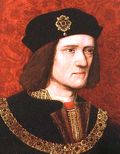 |
Richard III
b. 2 Oct 1452, Fotheringhay Castle, Northamptonshire
d. 22 Aug 1485, Bosworth Field, near Market Bosworth, Leicestershire [1] |
| Title: |
Dei Gracia Rex Anglie et Francie Dominus Hibernie (By the Grace of God, King of England and France and Lord of Ireland) |
| Term: |
26 Jun 1483 - 22 Aug 1485 |
| Chronology: |
26 Jun 1483, accepted the crown offered by the three estates of the realm, Baynard's Castle; same day occupied the king's chair in the court of King's Bench at Westminster [2][3] |
| |
between 23 Jan 1484 and 20 Feb 1484, recognized king by an act of Parliament (Titulus Regius) |
| |
6 Jul 1483, crowned, Westminster Abbey |
| |
22 Aug 1485, died |
| Names/titles: |
Original name: Richard Plantagenet; Duke of Gloucester [from 1 Nov 1461]; Protector & Defensor Regni nostri (Protector and Defender of Our [This] Realm) [after 7 May 1483 - 26 Jun 1483] (see details) |
| Biography: |
| Richard Plantagenet was the youngest son of Richard 3rd Duke of York, claimant to the throne of England, who was slain in the Battle of Wakefield when Richard was only eight (30 Dec 1460). Richard was created Duke of Gloucester (1 Nov 1461) by his older brother King Edward IV, who ousted the Lancastrian king Henry VI in March 1461. Richard participated in the War of the Roses and helped his brother in the battles of Barnet and Tewkesbury supporting his restoration in 1471. Designated protector of the realm in the last will of Edward IV, Richard learned about his brother's death on 11 Apr 1483. He promptly intercepted (30 Apr 1483) Edward's successor, Edward V, traveling from Shropshire to London, and entered the capital along with the young king on 4 May 1483. Acknowledged Protector by the king's Council upon his arrival, Richard eliminated his opponents and took full control over the king and his younger brother, Duke of York. The children of Edward IV were publicly declared illegitimate by Richard's supporters and an assembly of the three estates petitioned the Protector to accept the Crown (25 Jun 1483). At a meeting with lords and commoners at Baynard's Castle (26 Jun 1483), Richard accepted the crown and the same day rode to Westminster where he took the King's Bench, declaring himself to be king. After his coronation, Richard elevated his only legitimate son, Edward, as Prince of Wales. The rebellion of the king's former ally, Duke of Buckingham, was suppressed in November 1483. The first Parliament, summoned by Richard on 9 Dec 1483, assembled on 23 Jan 1484. It declared that Richard accepted the crown by inheritance and by lawful election and issued an act to that effect ("Titulus Regius"). Richard approved legal acts against benevolence and protection for merchants and craftsmen, but it was insufficient to counteract his public image as a villain, who usurped the throne and had his nephews murdered. On 9 Apr 1484 Prince Edward died leaving Richard III without a lawful heir. To reduce his commitments in the north, which gave him the strongest support during his reign, Richard concluded a three-year truce with Scotland (14 Sep 1484). The sole male claimant to Lancastrian ancestry Henry Earl of Richmond landed at Milford Haven on 2 Aug 1485. The army of Richard was utterly defeated in the Battle of Bosworth Field and he himself was slain (22 Aug 1485). Richard was posthumously attainted. His remains were discovered during the excavations in Leicester in 2012 and identified with the help of DNA testing. Richard was reburied at Leicester Cathedral on 26 Mar 2015. |
| Biographical sources: "The Usurpation of Richard III", by Domenico Mancini, translated by and with an introduction by C.A.J. Armstrong (Clarendon Press, Oxford 1969); "The Year of Three Kings", by Giles St Aubyn (Collins: London, 1983). |
| |
| [1] |
A proclamation issued by King Henry VII on 25 Aug 1485 names the place where Richard died: "And moreover the King ascertainet you that Richard, Duke of Gloucester, late called King Richard, was slain at a place called Sandford within the shire of Leicester..." |
| [2] |
Richard commenced his reign on 26 Jun 1483, when he occupied the king's chair in the court of King's Bench at Westminster. Doubt as to the commencement of Richard's regnal year persisted in outlying parts and he addressed a letter under his signet Nottingham on 12 Oct 1484 to Ireland certifying that he began his reign on 26 Jun 1483 when "we entred into owre just title taking upon us oure dignitie royall and supprane gouvernaunce of this our royme of England". |
| [3] |
"The inauguration ceremonies of the Yorkist kings and their title to the throne", by C.A.J. Armstrong in TRANSACTIONS OF THE ROYAL HISTORICAL SOCIETY (4) 30 (1948), pp. 51-74. |
| |
Image: portrait of King Richard III by an unknown artist, c. 1520. |

